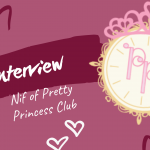Skirt Coordinates and How To Master Them
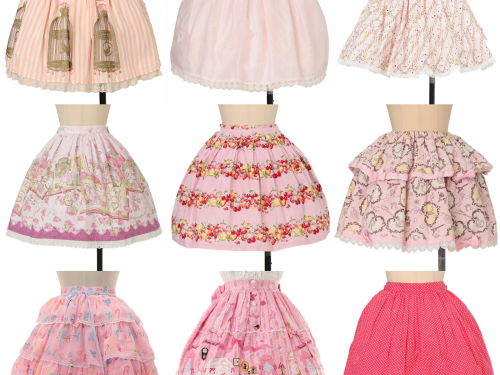
Despite being hugely versatile, I’ve noticed many people say they struggle with coordinating skirts. This used to be my problem too, so I can understand why they think that. Now a skirt is a staple in my wardrobe that I wear daily. So for those of you out there who have problems coordinating their skirts, hopefully some of these tips will help you.
Which is a Lolita Skirt?
First we must sift through the realm that is skirts. Japanese lolita brands release these pretty frequently, though probably less so than they used to. They also sometimes release skirts which are not actually suitable for lolita fashion. Remember, not everything the Japanese brands put out is necessarily lolita. When looking for lolita skirts, pay attention to two things: length and shape.
Most lolita skirts measure at least 50cm in length. Any less and it will be too short, exposing too much of your leg and petticoat. Longer is good, especially if you’re tall, but remember that anything over 70cm might need a different petticoat. There are certainly plenty of tea length dresses and skirts, although some argue whether the’re still lolita. On the other hand, brands have also released also some maxi length skirts, which would be more in the realm of aristocrat fashion. Therefore, for a skirt to be safely within lolita length, look for those measuring between 50 and 70cm in length.

From left to right these are from: Angelic Pretty, Metamorphose and Atelier Pierrot. All of these are prominent lolita brands, but only the middle skirt is lolita in shape and length.
Secondly, without the right silhouette your outfit will not be lolita. Luckily, most of the times if the skirt length is right, most likely the shape will be too. Shops specialising in lolita fashion, like Wunderwelt, display these with a petticoat, so you can see the silhouette properly. If it seems like there is no petticoat under the skirt, then it most likely isn’t meant for lolita fashion. Similarly, if the shape is not a bell or A-line, chances are it won’t fit the lolita silhouette correctly. Stick to what’s been tried and tested, unless you have an extremely good understanding of this fashion and coordinating.

From left to right these are from: Innocent World, Metamorphose and Miho Matsuda. The first two represent the two silhouettes present in lolita: A-line and cupcake. While the Miho Matsuda skirt is also A-line, it’s not big enough to accommodate a petticoat. Therefore, it won’t work for lolita fashion.
Why are Skirts Trickier to Coordinate?
Let’s make a quick detour to explore where the problems with coordinating skirts may come from in the first place. Understanding why some people feel like they aren’t succeeding is a vital tool in correcting their mistakes.
Unlike the JSK or the OP, a skirt leaves the torso exposed. This puts a lot more pressure on you to find a well fitted blouse. Gaping, bunching or wrong size can ruin the look of a coordinate without that extra fabric to cover the flaw up.
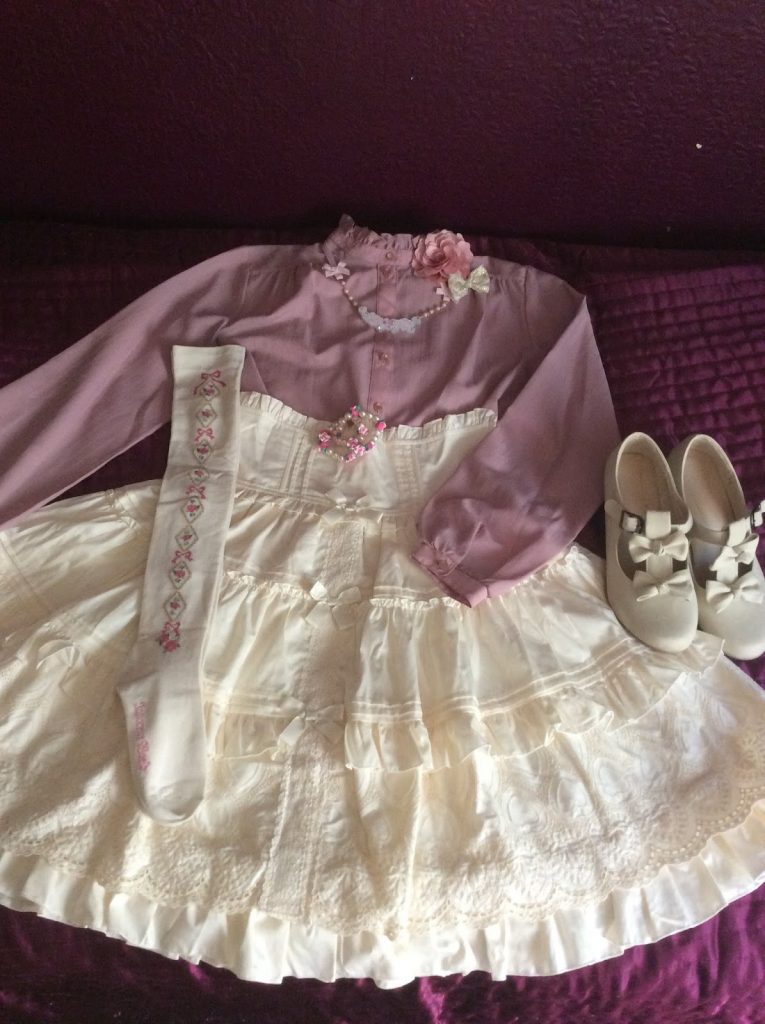
A blouse that fits well is important, since a skirt can expose any problem areas on the torso.
It also creates a large part of your coordinate looking potentially empty. Whereas a dress has a bodice with all kinds of details to keep the interest in your upper half, a skirt has none. Filling up this empty space can be tricky, particularly with regular waist skirts. Not every blouse has enough detail on the torso part, which can make skirts trickier to coordinate.
Additionally, a skirt throws the coordinate’s proportions and balance of colours off a little, as your entire blouse is visible. That means that whatever colour your blouse is, there’s visually more of it in the entire outfit. This in turn can put a bit more pressure on you to get the colours to match as closely as possible because there are fewer layers of separation to trick the eye.
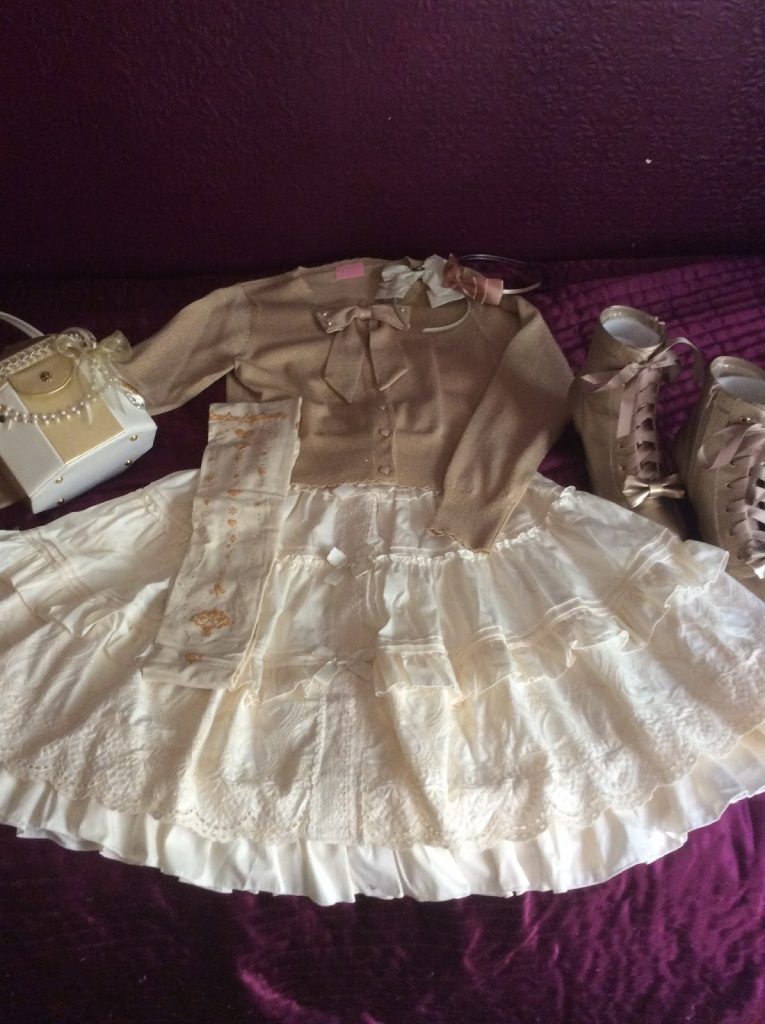
Getting the colours to match can be tricky anyway. Creating areas of separation can help, but with the skirt’s proportions you might need more of some shades to successfully balance them.
Lastly, not everyone likes the look of the skirts’ waists. Fully shirred ones are comfortable, but some don’t find that look attractive. On the flipside, if the skirt fits a little tight or is cut a certain way, it can exaggerate any problem areas across the torso. As such they can be a little less forgiving of a so-so fit than dresses, demanding more attention to getting just the right size.
The Main Skirt Styles
First, look at the skirt’s style, as we distinguish three main types: apron skirts, high waist and regular waist. If you already know why you struggled with coordinating skirts, getting the right cut might help overcome that.
Apron skirts can sometimes be mistaken for JSKs. In many cases, though not always, the bodice is detachable, allowing you to also wear it as a regular waist skirt. While these can be great to ease yourself into wearing skirts and make for versatile wardrobe additions, they are predominantly sweet in style. There may be some that will work with classic lolita, however, goths will find these hard to incorporate into their style.

From left to right these are from: Angelic Pretty, Innocent World and Metamorphose. Take away the apron bodice and you have a regular waisted skirt. With that bodice it resembles a JSK from the front, which helps when beginning to coordinate skirts.
This is where we move onto high waist skirts. These are predominantly classic or gothic and feature an extra panel above the waist seam. They cover more of your torso, sometimes going right under your bust. This is what makes them slightly less difficult to coordinate than regular waist skirts. On the other hand, not everyone likes the way they feel, particularly if the skirt is boned. This style can also accentuate those with larger chests, so if you don’t want to draw attention to that area, I suggest staying away from this cut.

From left to right these are from: Metamorphose, Alice and the Pirates and Angelic Pretty. High waist skirts are predominantly classic and gothic, but there are some sweet ones too. The gap between sweet and classic is bridging down, opening the doors to new cut and print combinations.
Lastly is the most common type, the regular waist skirt. They come in a wide variety of patterns, prints and sizes, ranging from completely non-shirred to fully-shirred. Sitting right at your waist, these show the most of your torso, which is where coordinating struggles happen. On the other hand, they are the closest to normie skirts other than miniskirts. This makes these fantastic for casual and daily wear, as they stand out a little bit less from the crowd. All the benefits of wearing cute clothes with fewer questions from the public? Yes, please!

From left to right these are from: Baby the Stars Shine Bright, Metamorphose and Triple Fortune. Long and short, plain and printed, one cut and tiered, shirred and not, representing every substyle possible – there is a regular waist skirt out there for everyone.
Tips for Coordinating Skirts
Wear a Vest
Referred to as a bustier by Japanese brands, a vest can fix most of the problems listed above. Choose one that complements the skirt, either by matching or contrasting, and it could make it look like a JSK. This allows you to coordinate the rest as you would with a JSK, thus putting you back into familiar territory. A lolita bustier will have the right amount of detail for the fashion, however, an offbrand vest can be decorated to match well. Make sure to get one that fits you well and pay attention to the neckline: round or square is more lolita than V-shaped. This won’t really apply to apron skirts, unless you wear then with the bodice detached, in which case read on for tip no 2.
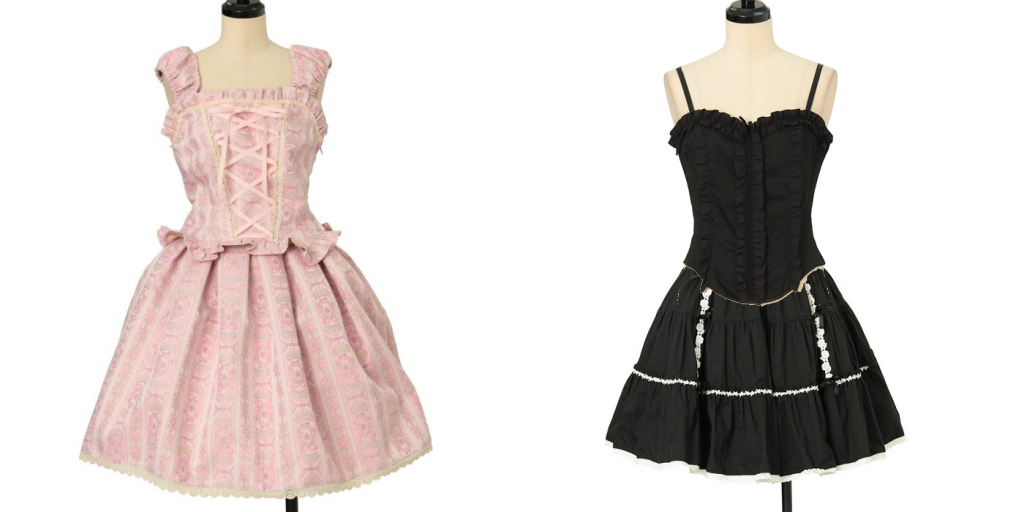
Sometimes you can find a ready skirt and vest set, like this Baby the Stars Shine Bright one. Sometimes you just have to match it. Paired with this Innocent World skirt, this Black Peace Now vest would fake that JSK look.
Wear Some Sort of Over-Garment
Don’t worry if vests aren’t your thing – a cardigan or a blazer jacket will work just as well! While they won’t transform your skirt into a JSK, they will do the same job of covering up your torso and adding some detail there. Plenty of skirts also come with matching blazers, so if you fit into those, take advantage of that for a cute, preppy look. Likewise, you’ll achieve a similar effect with other over-garments. Belts, corsets or even obi for Wa lolita coords – the key is to cover the skirt’s waistband. Having said this, these can be trickier than cardigans etc. if you’re not quite experienced with lolita fashion. So if you’re new to the fashion, start out with something simpler.
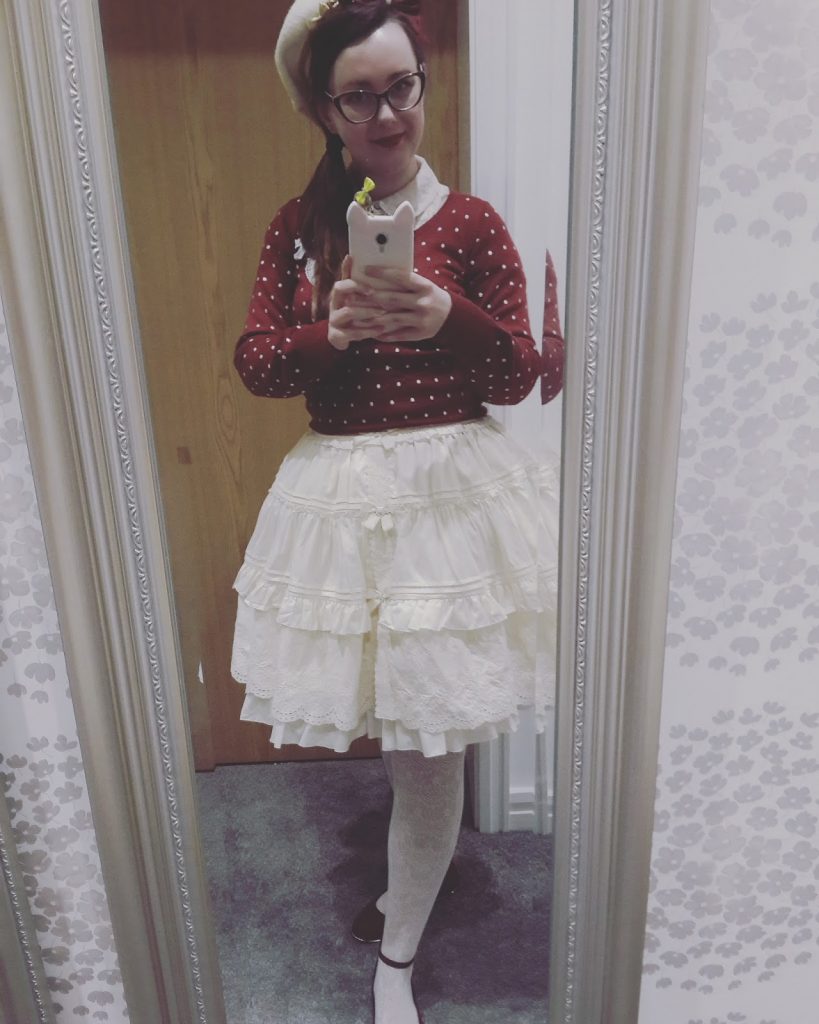
I am a big fan of cardigans. When the cut is well chosen, they can emphasize the nip in your waist, which can sometimes disappear in a lolita coordinate. And if it’s too long, simply try tucking it to match the skirt’s waist.
Bold Long Necklace
For those times when it’s too hot to wear anything over your top, you should carefully consider your accessories. A statement necklace on a long chain can provide that vital detail just above your skirt waistline to balance everything out. And by big I mean clearly visible and identifiable from an outfit picture on Instagram kind of big. Aim for approximately 60cm length chain to ensure that the pendant sits just below your chest. That way you it will hit precisely the point where it seems like there isn’t enough detail on a skirt coordinate. Luckily, this can be a very cheap trick, as you can craft exactly the kind of necklace you need. In the meantime, those less crafty can rely on a plethora of brands, from Japanese to indie, to fill that need.
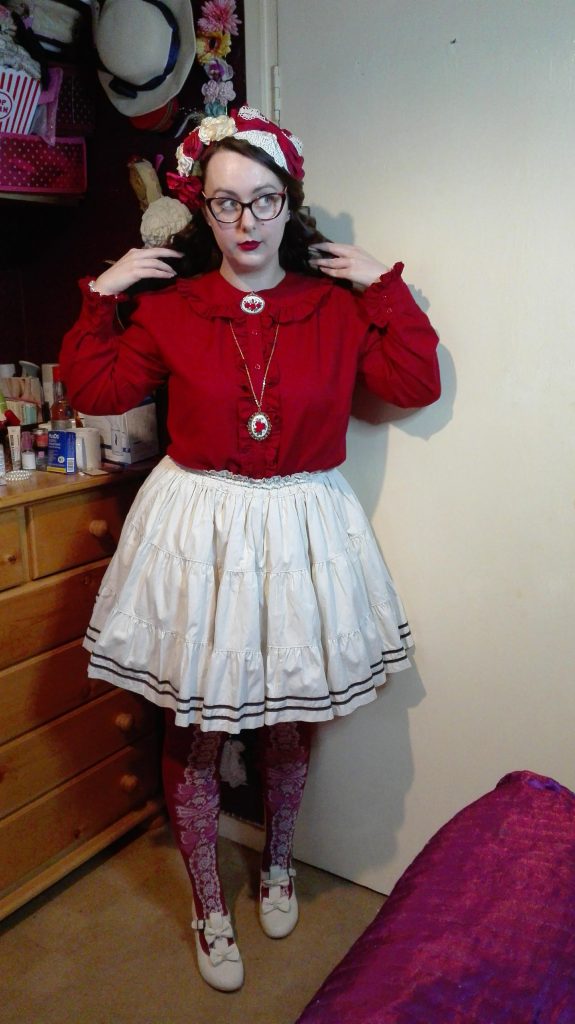
This necklace creates a focus point on the torso, where otherwise would’ve been empty space. Additionally balanced by a matching brooch, it adds detail to the blouse, as well as balances colours.
Swap Blouses for Cutsews
An cutsew can look really cute with a skirt, particularly if it’s a simpler design. Since with a skirt there’s less of the garment itself compared to a JSK, they already have a more casual look. Play that casual vibe up and enjoy a less fussy outfit. You can even go one step further and wear your lolita skirt with a non-lolita T-shirt for maximum cute casual look. What’s more, cutsews tend to bypass the fit issue that can make skirt coordinates look off. Because the cutsew fabric accommodates a wider range of body shapes, stretching and tightening where necessary, you can wear it tucked or untucked. And luckily, there are cutsews of all styles and fanciness level, so you can find just the right one for your skirt!
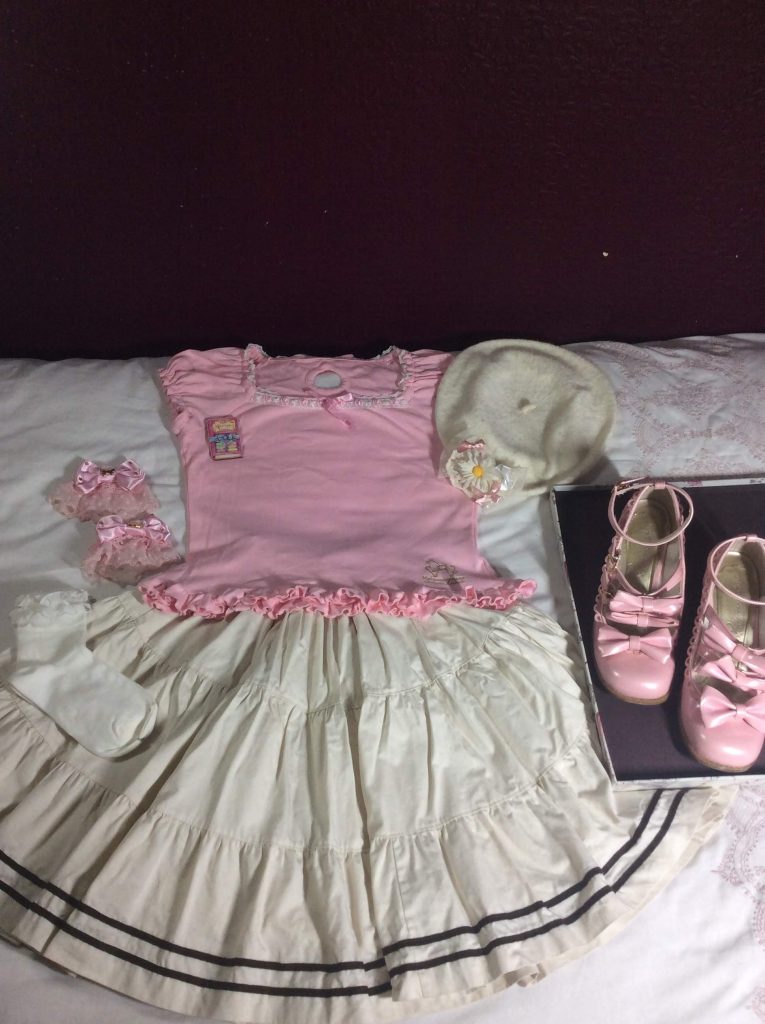
A cutsew is both cute and comfortable, so it’s easy to wear with a skirt for casual coordinates. Although these days there are also some fancier cutsews for less casual looks.
But Careful with Untucked Blouses
After a success with the cutsew, it can be tempting to try leaving your blouse over the skirt to cover the waistband. However, this can quickly turn messy if you don’t pay attention to the fit and the overall look of a coordinate. Finding a blouse that is neither too long nor too short and fits you well across your torso is absolutely essential. You want to avoid showing skin every time you lift your arms, as well as the blouse covering too much of your skirt. This is particularly important with bell-shaped skirts, where too long a blouse would hide the top of your poof and mess up your silhouette.
Embrace the Torso Space
Sometimes it only seems like there’s a big empty gap above the skirt because we’re so used to JSKs. Brave your fears and just go for it with your coordinate! Provided that your blouse fits well and you’re not constantly adjusting it or feeling uncomfortable, it will look great. And trust me, after building your confidence up with the other tips, you will soon learn to embrace the look of a humble skirt.
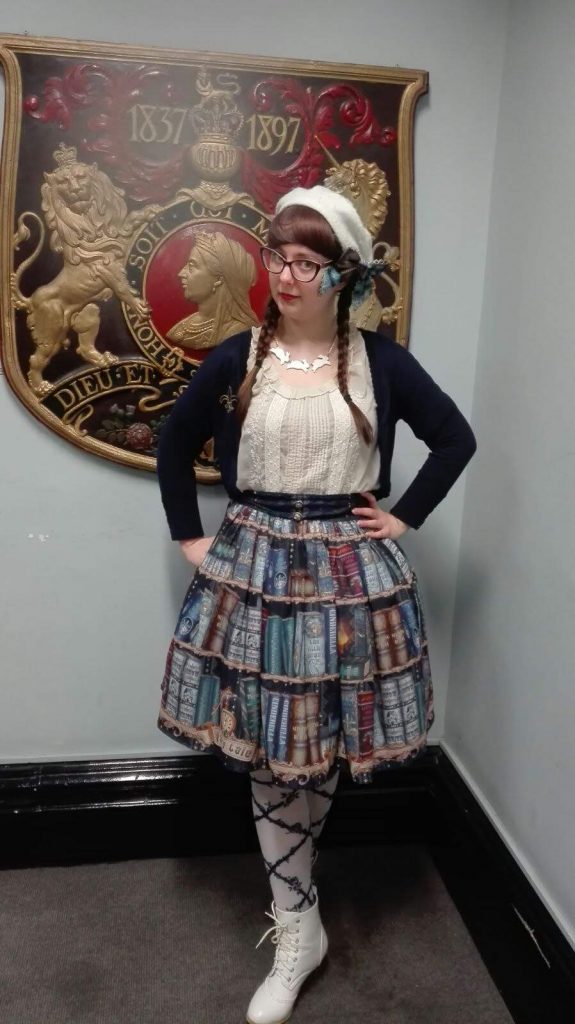
Sometimes you don’t need all those extras to make the skirt work. You just need to wear it with confidence!
She/her.
29-year-old Capricorn, Polish-born, UK-based and in love with Japanese fashion (predominantly Lolita). I enjoy a good bargain, OTT coords, cats and baking, and when in Japan I’m a self-confessed purikura addict. When I don’t blog, I work in the education sector, overseeing international exchange programs, and sometimes I get to do some exciting freelance translations on the side.







